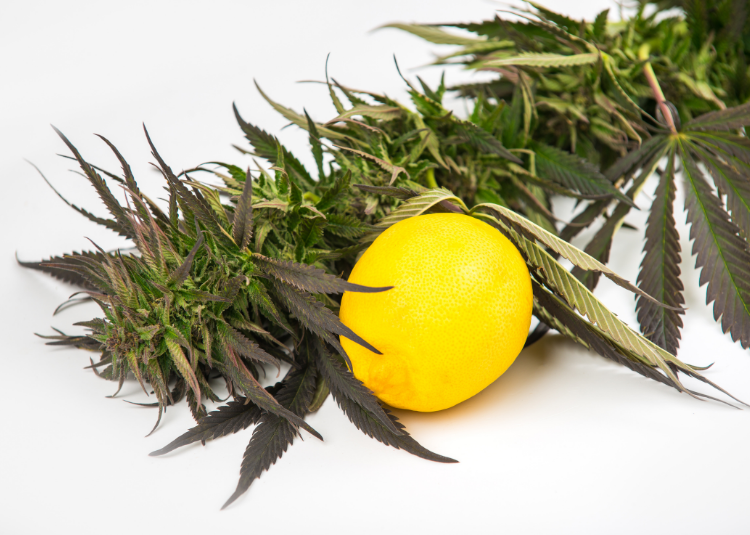Of course cannabinoids such as THC and CBD are important active ingredients in the cannabis plant. But terpenes also play a major role in the effect and efficacy of cannabis. It is therefore important to know more about these substances, especially for medicinal cannabis users.
What does the dictionary say about terpenes?
Van Dale’s Great Dictionary is often a good starting point for understanding a word better. Van Dale gives the following meaning:
Terpene: (the; terpenes) (chem.) name for a class of organic compounds whose molecular basic skeleton can be understood as an oligomer of isoprene, for example limonene, the molecule of which is composed of two isoprene molecules and which is referred to as monoterpene. <1901-1925> shortened from terpentine
These few lines immediately indicate that this is not a simple matter. Oligomer means: composed of a small number of parts. Isoprene is an unsaturated hydrocarbon, easily oxidizable, of which the molecule C5H8 forms the basic unit of terpenes and rubber. Limonene is one of the best-known terpenes, recognizable by its lemon scent. Limonene consists of two isoprene molecules and therefore belongs to the group of monoterpenes.
Terpenes and terpenoids
Cannabis expert Jason S. Lupoi explains in a recent article on terpenesandtesting.com, “Often times, the word terpene refers to many different molecules such as limonene, pinene or caryophyllene. Sometimes this term is used for convenience even when the molecules are not technically terpenes, but rather terpenoids such as linalool, geraniol or fenchol. The difference is in the elements that make up the molecule. If carbon (C) and hydrogen (H) are the only two elements present, it is a terpene. If another element such as oxygen (O) is present, it is a terpenoid.”
Alcohols
A third variant are the alcohols. Lupoi: “Alcohols have -OH groups in their molecular structure and their names end in -ol, so geraniol, linalool, bisabolol, and so on. They are terpene alcohols. These substances can also be separated into their individual components, such as phenchyl alcohol or linalyl alcohol, but they mean the same thing, such as isopropanol and isopropyl alcohol. “
Terpenes and terpenoids have a different vapor pressure. A substance with a high vapor pressure has a high volatility and thus evaporates more easily in a gas. Lupoi: “Terpenes have a vapor pressure between 100-550 Pascal at 25 ° C. Terpenoids have a vapor pressure between 1-130 Pascal at 25 ° C.”
Monoterpenes and Sesquiterpenes
The difference between monoterpenes and sesquiterpenes is also in the chemical structure. “A monoterpene has ten carbon atoms and sixteen hydrogen atoms,” said Lupoi. “Monoterpenes include myrcene, terpinene and sabinene. A molecule can also be referred to as a monoterpenoid, for example monoterpenoid alcohols such as terpineol or borneol and monoterpenoid ketones such as camphor. The sesquiterpene is bulkier, with 15 carbon atoms and 24 hydrogen atoms. The most common sesquiterpene is betacaryophyllene; others are cedrene, farnesene and humulene. And there are also sesquiterpenoids such as bisabolol, guaiol and nerolidol (alcohols) or germacrone (ketones).”
Aroma of the plant
Because monoterpenes are generally more volatile than sesquiterpenes and are thus more easily converted to vapor, they contribute greatly to the smell of a plant. Lupoi: “Sesquiterpenes certainly contribute to a plant’s aroma as well, but their organic chemistry provides greater resilience to linger in the plant.”
The more we learn about terpenes, the more important these substances will become. For consumers and patients and therefore also for the market and growers.
The concentrations of monoterpenes decrease during the drying and storage of cannabis. According to Kenneth Morrow, author of the Handbook of Essential Oils, no less than sixty percent of the terpenes in the plant disappear during the drying process. That is why some growers freeze their cannabis immediately after harvest to preserve as much monoterpenes as possible. Note: this is cryogenic freezing, aslo known as flash freezing, so not with a regular freezer.
Lupoi notes that by crushing cannabis in a grinder, you also lose monoterpenes. And also in the processing of cannabis with the application of heat to decarboxylate. When many of the monoterpenes have disappeared, the less volatile sesquiterpenes, such as caryophyllene, remain. Cannabis with a dominant content of caryophyllene has a taste and smell reminiscent of black pepper or cloves. This is actually a red flag for weed with few monoterpenes.
Supercritical CO2 extraction
The most optimal method to preserve terpenes, monoterpenes and sesquiterpenes is the so-called supercritical CO2 extraction. This process requires expensive equipment and expertise, but no chemicals are required and it is a sustainable method. Carbon dioxide, or CO2, acts as a solvent under certain pressures and temperatures. In supercritical extraction, CO2 acts as a liquid and as a gas. By varying the pressure and the temperature you can extract specific substances. The result are modern concentrates such as shatter, wax and budder, collective name: dabs.
If the concentrate maker has done a good job, you will taste and smell a wide and intense palette of scents and flavors, as many terpenes have been retained. You use modern concentrates with a “dab rig”, a glass pipe with a ceramic element that you heat up before you put a dab of concentrate, a dab, on it. The heat evaporates the concentrate and by inhaling this vapor you get all the active substances. Without tobacco, of course. Unfortunately, these types of concentrates are still banned in most European countires, but in North America they fly over the counter of the marijuana dispensaries.
Making “live rosin” yourself
Medical cannabis users with their own plants can experiment with making “live rosin”. Not to be confused with “live resin”, which is made from cryogenically frozen cannabis.
Sources used for this article:
Van Dale’s dictionary
The Language Behind Terpenes, Terpenoids, Monoterpenes, and Sesquiterpenes – by Jason S. Lupoi, Ph.D.,
TerpenesandTesting.com, August 14, 2020
Sub- v. Supercritical CO2 Extraction, Extraction Magazine, September 19, 2018
What is Live Resin & What’s the best way to use it? Herb.co, April 6, 2016
Live Resin: Material and Preparation, Extraction Magazine, May 18, 2018

